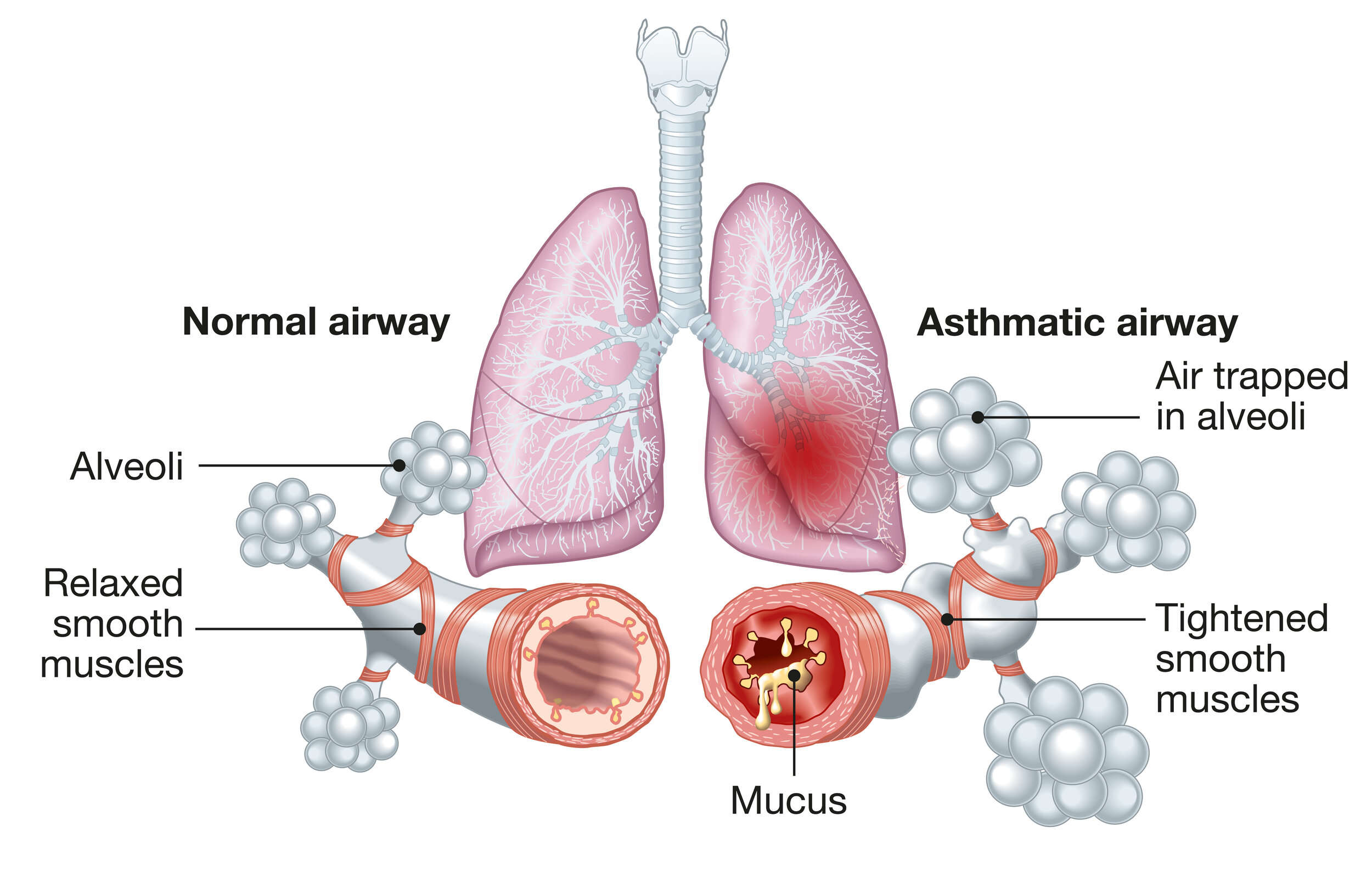Yes, cats get asthma
that cough might not just be a fur ball
If your cat seems to be frequently trying to hack up a hairball or you can hear wheezy breathing, then it’s possible your cat has feline asthma. This can have serious consequences but is also highly treatable.
What is feline asthma?
Feline asthma goes by a few different names: allergic bronchitis, asthmatic bronchitis, allergic airway disease, chronic bronchitis and feline small airway disease. Let’s stick with asthma for the moment.
Asthma is a condition affecting the small airways in the lungs called bronchioles.
With asthma, these airways become narrow (constricted) due to:
accumulation of mucus
swelling (and even ulceration) of the airway walls
spasm of the airway muscles
The narrower the airways, the harder it is to move air in and out. Think about how much more effort it takes to suck something up through a pinched straw than a wide open one.
Yes, this a diagram of human lungs, but the same process is happening in feline asthma
What causes asthma in cats?
Feline asthma appears quite similar to human asthma. Some individuals have certain things that trigger their airways to overreact.
The triggers are sometimes called aeroallergens. When inhaled, they go down into the lower airways and stick to the airway lining (mucosal surface). Here they interact with the immune system and cause what’s called a type I hypersensitivity reaction. The end result of this reaction is eosinophilic airway inflammation, mucous hypersecretion, bronchoconstriction, smooth muscle spasm, vascular leakage and airway remodelling.
Triggers for feline asthma include:
cigarette smoke
dust
dust mites
mildew/mold
grass, weed and tree pollens
dusty cat litter
household sprays – air fresheners, bug sprays
carpet cleaning powders
It’s not uncommon that we can’t identify any specific trigger.
NOTE:
It worth mentioning chronic bronchitis here. This is the other main chronic lower airway disease in cats and often gets lumped in with asthma. It’s very similar as triggers cause airway inflammation (and therefore narrowing) but it doesn’t involve bronchial muscle spasm (bronchoconstriction). This means it doesn’t so much come in episodes but rather as a chronic daily cough.
What are the signs of feline asthma?
The signs of asthma in cats are:
breathing difficulty/distress
chronic or intermittent cough
wheezing
The severity of these is highly variable. Some cats have mild disease and just occasionally have a brief bout of coughing. Others will cough, wheeze and struggle to breath on a daily basis. And severely affected cats will cough persistently and experience episodes of life-threatening airway constriction.
breathing difficulty
A severe asthma attack may start with a bout of coughing and as the airways constrict, you may hear a distinct wheeze and see your cat having more difficulty breathing.
Difficulty breathing is called dyspnoea. The signs of dyspnoea in a cat include:
open mouth breathing
an extended head and neck
rapid, shallow breaths
abdominal breathing – where you can see the abdomen obviously moving in time with breathing as the abdominal muscles are trying to help the chest muscles
a hovering position (chest and belly off the ground) but legs bent, with elbows often flaring out
Dyspnoeic cats are very fragile. Any extra stress can worsen their breathing and lead to cardiopulmonary arrest.
Chronic or intermittent cough
Cats with mild asthma (or chronic bronchitis) may ‘just’ regularly cough. This cough may sound very wheezy. Breathing is often normal between episodes of coughing. Some cats will have a higher respiratory rate and sound a bit wheezy all the time.
If the chronic cough is due to asthma rather than chronic bronchitis, it’s possible for you to see episodes of acute respiratory distress on a background of chronic coughing.
How is asthma diagnosed in cats?
There are no specific tests in general practice that definitively diagnose feline asthma.
We use clinical criteria to make a diagnosis:
a history of a chronic cough or acute dyspnoea (without another obvious cause) or if we can hear a wheeze (air moving through a narrowed small airway)
chest X-rays
response to trial therapy
X-RAYS
The classic feline asthma radiograph shows:
visible small airways – because the walls are swollen and lined with mucus, they show up on X-ray and appear as ‘tramlines’ (viewed side on) and ‘donuts’ (viewed end)
air trapping – because the airways are constricted, it’s not just hard to move air in, it’s also hard to move out and so the lungs can become overinflated, taking up more room in the chest and pushing the diaphragm down so it appears flattened
collapse (atelectasis) of the right middle lung lobe – due to mucus build up
Visible features of asthma are not always present though. It is possible for an asthmatic cat to have normal X-rays. It’s also possible for coughing and dyspnoea to be due to diseases other than asthma.
When looking at chest X-rays, we are also assessing for other respiratory disease (eg pneumonia, lung worm, neoplasia), heart disease (eg cardiomyopathy) and chest cavity disease (eg fluid in the pleural space, tumours).
Trial therapy
If a cat has symptoms of asthma but normal X-rays and no evidence of another cause, we often use response to therapy as a diagnostic tool.
The sort of airway constriction that occurs with asthma is reversible. Hence, if we give a medication and see a rapid response, a diagnosis of asthma is very likely.
The medications given include:
bronchodilators
corticosteroids
adrenaline – in an acute crisis
If we see resolution of symptoms, then we continue therapy. If we don’t, we might need further diagnostics.
How is asthma treated?
Treatment of asthma generally requires both environmental changes (to minimise triggers) and medication.
Where possible, we will try to use inhaled medications. This is so we can deliver the medication to where we need it to work – the lower airways. However, when first starting treatment, we might use oral or injectable medications and then switch over to inhaled (if we can).
Inhaled medication administration
We can’t get cats to take a deep breath in on an inhaler. But we can often get them to accept a spacer device and mask similar to those used with infants/small children.
See a video of an AeroKat® spacer
Corticosteroids
The most commonly used inhaled medication for cats with asthma is fluticasone propionate (Seretide®). This is a potent corticosteroid that is usually given daily to control airway inflammation. It can take around 1–2 weeks to see its full effects.
BRONCHODILATORS
We may also use a bronchodilator such as albuterol (Ventolin®) during episodes of airway constriction.




